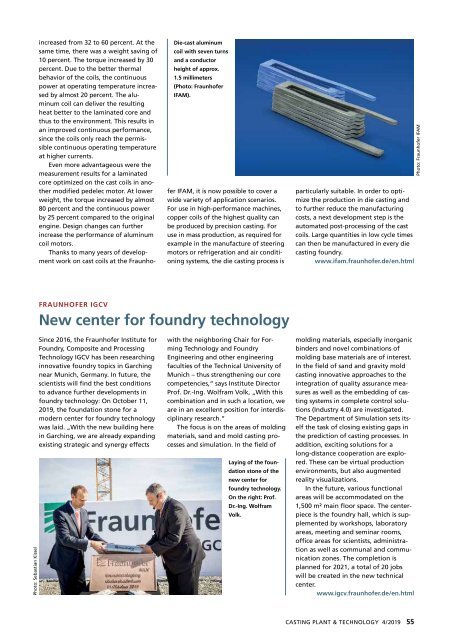CPT International 4/2019
You also want an ePaper? Increase the reach of your titles
YUMPU automatically turns print PDFs into web optimized ePapers that Google loves.
Die-cast aluminum<br />
coil with seven turns<br />
and a conductor<br />
height of approx.<br />
1.5 millimeters<br />
(Photo: Fraunhofer<br />
IFAM).<br />
increased from 32 to 60 percent. At the<br />
same time, there was a weight saving of<br />
10 percent. The torque increased by 30<br />
percent. Due to the better thermal<br />
behavior of the coils, the continuous<br />
power at operating temperature increased<br />
by almost 20 percent. The aluminum<br />
coil can deliver the resulting<br />
heat better to the laminated core and<br />
thus to the environment. This results in<br />
an improved continuous performance,<br />
since the coils only reach the permissible<br />
continuous operating temperature<br />
at higher currents.<br />
Even more advantageous were the<br />
measurement results for a laminated<br />
core optimized on the cast coils in another<br />
modified pedelec motor. At lower<br />
weight, the torque increased by almost<br />
80 percent and the continuous power<br />
by 25 percent compared to the original<br />
engine. Design changes can further<br />
increase the performance of aluminum<br />
coil motors.<br />
Thanks to many years of development<br />
work on cast coils at the Fraunhofer<br />
IFAM, it is now possible to cover a<br />
wide variety of application scenarios.<br />
For use in high-performance machines,<br />
copper coils of the highest quality can<br />
be produced by precision casting. For<br />
use in mass production, as required for<br />
example in the manufacture of steering<br />
motors or refrigeration and air conditioning<br />
systems, the die casting process is<br />
particularly suitable. In order to optimize<br />
the production in die casting and<br />
to further reduce the manufacturing<br />
costs, a next development step is the<br />
automated post-processing of the cast<br />
coils. Large quantities in low cycle times<br />
can then be manufactured in every die<br />
casting foundry.<br />
www.ifam.fraunhofer.de/en.html<br />
Photo: Fraunhofer IFAM<br />
FRAUNHOFER IGCV<br />
New center for foundry technology<br />
Photo: Sebastian Kissel<br />
Since 2016, the Fraunhofer Institute for<br />
Foundry, Composite and Processing<br />
Technology IGCV has been researching<br />
innovative foundry topics in Garching<br />
near Munich, Germany. In future, the<br />
scientists will find the best conditions<br />
to advance further developments in<br />
foundry technology: On October 11,<br />
<strong>2019</strong>, the foundation stone for a<br />
modern center for foundry technology<br />
was laid. „With the new building here<br />
in Garching, we are already expanding<br />
existing strategic and synergy effects<br />
with the neighboring Chair for Forming<br />
Technology and Foundry<br />
Engineering and other engineering<br />
faculties of the Technical University of<br />
Munich – thus strengthening our core<br />
competencies,“ says Institute Director<br />
Prof. Dr.-Ing. Wolfram Volk, „With this<br />
combination and in such a location, we<br />
are in an excellent position for interdisciplinary<br />
research.“<br />
The focus is on the areas of molding<br />
materials, sand and mold casting processes<br />
and simulation. In the field of<br />
Laying of the foundation<br />
stone of the<br />
new center for<br />
foundry technology.<br />
On the right: Prof.<br />
Dr.-Ing. Wolfram<br />
Volk.<br />
molding materials, especially inorganic<br />
binders and novel combinations of<br />
molding base materials are of interest.<br />
In the field of sand and gravity mold<br />
casting innovative approaches to the<br />
integration of quality assurance measures<br />
as well as the embedding of casting<br />
systems in complete control solutions<br />
(Industry 4.0) are investigated.<br />
The Department of Simulation sets itself<br />
the task of closing existing gaps in<br />
the prediction of casting processes. In<br />
addition, exciting solutions for a<br />
long-distance cooperation are explored.<br />
These can be virtual production<br />
environments, but also augmented<br />
reality visualizations.<br />
In the future, various functional<br />
areas will be accommodated on the<br />
1,500 m² main floor space. The centerpiece<br />
is the foundry hall, which is supplemented<br />
by workshops, laboratory<br />
areas, meeting and seminar rooms,<br />
office areas for scientists, administration<br />
as well as communal and communication<br />
zones. The completion is<br />
planned for 2021, a total of 20 jobs<br />
will be created in the new technical<br />
center.<br />
www.igcv.fraunhofer.de/en.html<br />
CASTING PLANT & TECHNOLOGY 4/<strong>2019</strong> 55

















